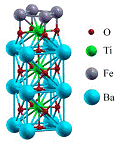Department of Physics and Astronomy: Publications and Other Research
Date of this Version
8-3-2018
Citation
Physical Review Letters 121, 056601 (2018).
DOI: 10.1103/PhysRevLett.121.056601
Abstract
Recent experimental results have demonstrated ferroelectricity in thin films of SrTiO3 induced by antisite TiSr defects. This opens a possibility to use SrTiO3 as a barrier layer in ferroelectric tunnel junctions (FTJs)—emerging electronic devices promising for applications in nanoelectronics. Here using density functional theory combined with quantum-transport calculations applied to a prototypical Pt/SrTiO3/Pt FTJ, we demonstrate that the localized in-gap energy states produced by the antisite TiSr defects are responsible for the enhanced electron tunneling conductance which can be controlled by ferroelectric polarization. Our tight-binding modeling, which takes into account multiple defects, shows that the predicted defect-assisted tunneling electroresistance effect is greatly amplified when the defect energy levels are brought to the Fermi energy by one of the polarization states. Our results have implications for FTJs based on conventional ferroelectric barriers with defects and can be employed for the design of new types of FTJs with enhanced performance.


Comments
Copyright 2018 American Physical Society. Used by permission.